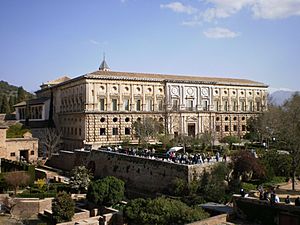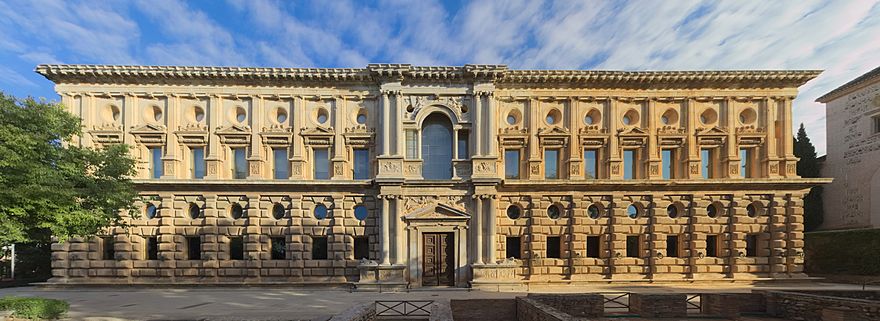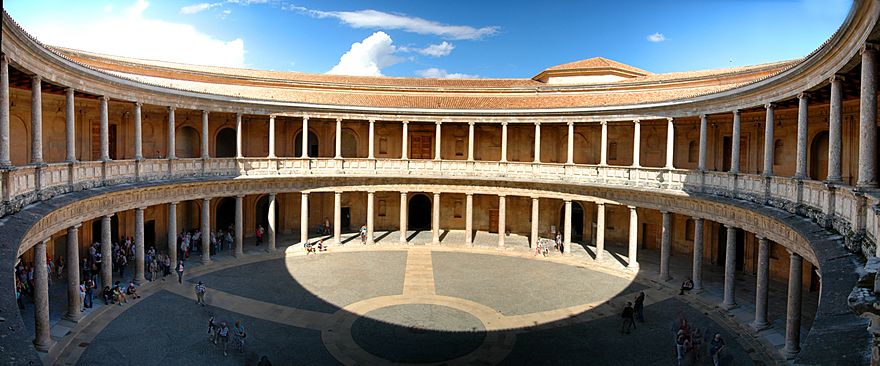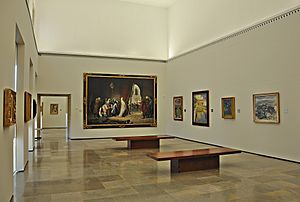Palace of Charles V facts for kids
The Palace of Charles V is a beautiful Renaissance building. You can find it in Granada, southern Spain. It's actually inside the famous Alhambra, which used to be a big palace complex built by the Nasrid rulers.
Building the palace started in 1527. But it took a very long time and was left unfinished after 1637. This means the palace was never actually lived in by a king or queen. It even stood without a roof until 1967! Today, the building is home to two museums. The Alhambra Museum is on the ground floor. The Fine Arts Museum of Granada is on the upper floor.
Contents
History of the Palace
King Charles V ordered this palace to be built right in the middle of the Alhambra. The design was made by Pedro Machuca. He was an architect who learned from famous artists like Michelangelo in Rome. Machuca knew a lot about the High Renaissance style. This was a time when art and architecture were very grand and balanced.
The palace was designed in a modern Renaissance style. This style was also called "Roman" because it copied ideas from ancient Roman buildings. It showed new ideas about how buildings should look. King Charles V wanted this grand palace to show his power. It also symbolized that Christianity had won over Islam in Spain. This was a big deal for his grandparents, the Catholic Monarchs.
Building the palace started in 1527. After Machuca died in 1550, his son Luis continued the work. Luis finished the outside walls and built the round courtyard inside. Work stopped for 15 years because of the Morisco Rebellion in 1568. The palace was still not finished when King Philip IV visited in 1628. The project was finally stopped in 1637. This left the building without a roof.
Because it had no roof, the palace got damaged over the years. People even used it to store gunpowder and other things. During the Peninsular War (1810-1812), French soldiers took over the Alhambra. They burned any wooden furniture they found inside the palace to make fires.
The palace was finally completed after 1923. Leopoldo Torres Balbás started its restoration. The roof was finished in 1967. A small "Arab museum" opened in the building in 1928. In 1942, it became the Archeological Museum of the Alhambra. Then in 1995, it became the "Alhambra Museum" we know today. It is on the ground floor. In 1958, another museum, the Fine Arts Museum of Granada, opened on the upper floor.
Palace Design and Architecture
The palace has a very interesting design. It is a square building on the outside, about 63 meters (207 feet) wide. But inside, it has a circular patio (courtyard). This circular courtyard is about 17 meters (56 feet) high. Having a square outside and a circle inside was very new for Renaissance architecture. It made the building very modern for its time.
The palace has two main floors. The lower floor uses the Tuscan order style. This means it has strong, simple columns called pilasters. The upper floor uses the Ionic order style. This style has more decorative columns. The main entrances on both sides are made of stone from the Sierra Elvira mountains.
The circular courtyard also has two levels. The lower level has a Doric colonnade. This means it has many simple, strong columns made of stone. The upper level has a more stylish Ionic colonnade. This design shows a deep understanding of Roman architecture. It fits the pure Renaissance style, but its curved shape is a surprise. This combination of square and circle is also used in the inner rooms and staircases. These design ideas later became part of a style called Mannerism.
Museums Inside the Palace
Alhambra Museum
The Alhambra Museum started as a small "Arab museum" in the Palace of Charles V in 1928. Before that, a similar museum existed in Granada since 1870. In 1942, it became the Archeological Museum of the Alhambra. Finally, in 1994–1995, it became the Alhambra Museum. It is now located on the ground floor of the palace.
The museum displays many old objects and artworks from the Alhambra. These items range from the early Islamic period of Granada to the Nasrid period. There are also some other Islamic art objects from different places. You can see marble pieces from the 10th century. These are from places like Madinat al-Zahra. There are also parts of the original decorations from the Nasrid palaces. This includes pieces from palaces that no longer exist, like the Alijares Palace.
You can also find Nasrid marble fountains and sculptures. One famous piece is a marble lion from the Maristan. The museum also has various other Nasrid-era furnishings. A special highlight is the Vase of the Gazelles. This is a huge and beautifully decorated ceramic vase from the 14th century. It is one of the famous "Alhambra vases."
Fine Arts Museum of Granada
The Fine Arts Museum moved into the palace in 1958. It is now on the upper floor. This museum shows a collection of paintings and sculptures from Granada. These artworks date from the 16th to the 20th centuries. Most of the collection comes from properties of the Catholic church. For example, many pieces are from the Cartuja in Granada. Others are from different monasteries and convents.
Some of the important artworks include The Burial of Christ by Jacopo Torni. There is also Thistle Still-Life by Juan Sánchez Cotán. You can also see a special Limoges enamel piece. The museum also has paintings by a 20th-century artist named Manuel Angeles Ortiz.
See also
 In Spanish: Palacio de Carlos V para niños
In Spanish: Palacio de Carlos V para niños






